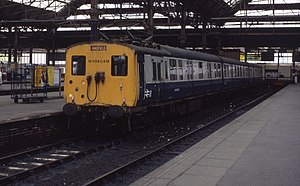British Rail Class 506
| British Rail Class 506 | |
|---|---|

A Class 506 at Manchester Piccadilly in 1984, shortly before withdrawal.
|
|
| In service | 1954–1984 |
| Manufacturer | Metro Cammell and Birmingham Railway Carriage and Wagon Company |
| Number built | 8 trainsets |
| Formation | 3 cars per trainset |
| Capacity | MOBS 52 seats, TOS 64 seats, DTOS 60 seats. |
| Operator(s) | British Rail |
| Specifications | |
| Train length | 177 ft 10 in (54.20 m) |
| Width | 9 ft 3 in (2.82 m) |
| Height | 12 ft 8 1⁄4 in (3.87 m) |
| Maximum speed | 75 mph (121 km/h) |
| Weight | MOBS 50 long tons 12 cwt (51.4 t; 56.7 short tons), TOS 26 long tons 8 cwt (26.8 t; 29.6 short tons), DTOS 27 long tons 9 cwt (27.9 t; 30.7 short tons) |
| Power output | 740 hp (550 kW) per 3-car set |
| Electric system(s) | 1,500 V DC overhead |
| Track gauge | 4 ft 8 1⁄2 in (1,435 mm) standard gauge |
The British Rail Class 506 was a 3 carriage Electric Multiple Unit (EMU) built for local services between Manchester, Glossop and Hadfield on the Woodhead Line, which was electrified in 1954 on the 1,500V DC overhead system.
There were eight three-car units, ordered in 1938 by the LNER and built in 1950, but they did not enter service until June 1954. Similar in design to the Class 306 EMUs (prior to their conversion to 25 kV 50 Hz AC operation), and built on the same production lines (making a total of 100 units of basically similar design), they were equipped with air-operated sliding doors.
Each unit was formed of a Driving Motor Brake Third (seating 52); a Trailer Composite (seating 24 first class and 38 third class passengers); and a Driving Trailer Third (seating 60). Third class was redesignated Second across the whole of BR on 3 June 1956, while the first class seating of these units was declassified to second in early 1960.
The eight 3-car sets were formed into 6-car trains at peak hours. The frequency of the Glossop/Hadfield service at peak times was every 30 minutes, and the round trip took nearly 90 minutes, requiring six of the eight units in service each weekday. With one spare unit, and one away for works overhaul at a time, there was no scope to use the units for other tasks.
The EMUs were equipped with a single diamond-shaped pantograph, mounted over the driver's cab and adjacent guard's compartment at the outer end of the driving motor carriage. This gave a ready identification feature, because (following the withdrawal of the Manchester-Altrincham units in May 1971), all other overhead-line EMUs operating in the Manchester area had the motor coach (and thus the pantograph) in the middle of the unit.
Unlike class 306, the eight class 506s remained solely equipped for 1,500V DC operation for their entire lives. This made them unable to operate on any lines other than the Woodhead route — although they rarely operated east of Hadfield due to low gearing and the risk of overheating.
...
Wikipedia
